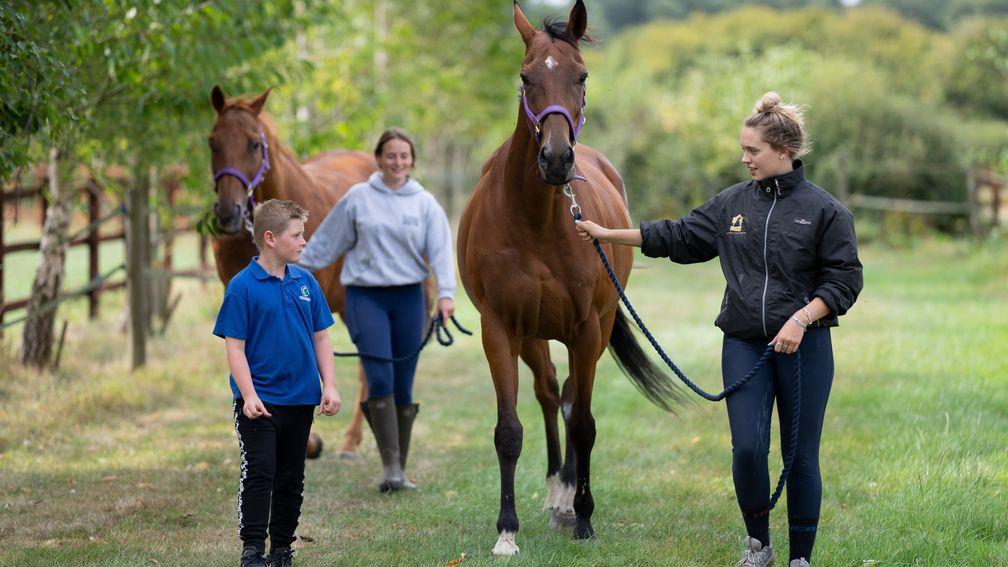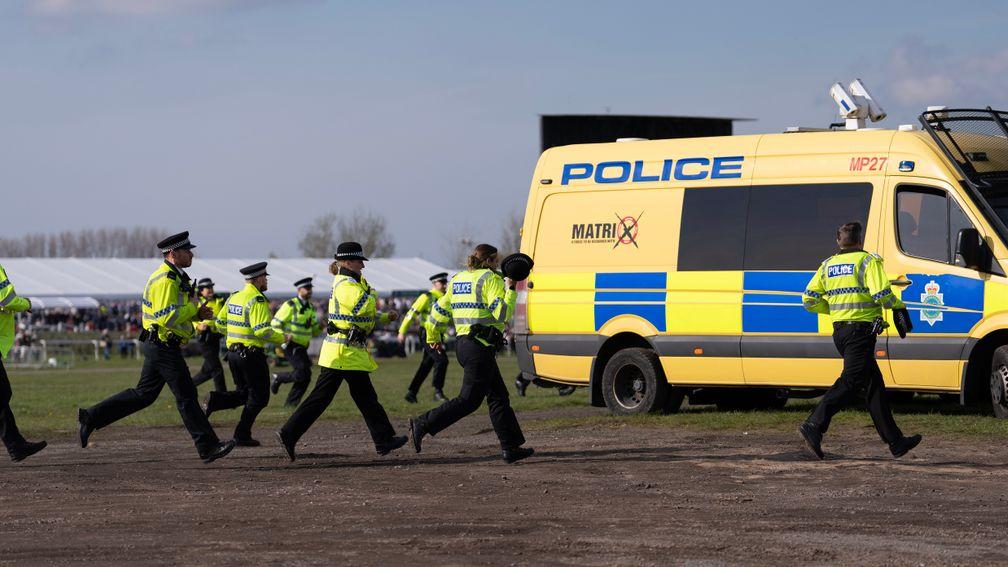- More
'This is an investment in the future of racing - it's vital if we are to have a vibrant racing sector for the next 30 years'
Lewis Porteous finds out how British racing is progressing on its welfare aims ahead of the sport's biggest day

It was pure chaos. Scores of protesters were trying to scale perimeter fences, others had got in and were attempting to glue themselves to fences on the course, all while police using riot vans and trained dogs, security and angry locals did everything they could to stop them. Darren Owen, commentating on the race for BBC Radio 5 Live, would later say it was “like a war zone”.
Ultimately, the animal rights activists, organised by the protest group Animal Rising, were unsuccessful in their mission to prevent last year’s Randox Grand National from taking place. But, having caused a 14-minute delay to the great race just as millions had tuned in to watch, they had certainly made an impression.
The dramatic scenes underlined the fact that the Grand National, as the biggest race in British racing, has increasingly become a focal point for public interest in racehorse welfare.
"It always seems to me that the tone for the year is set by four days in the Cotswolds and one race at Liverpool. That's what the public will pick up on," says James Given, the BHA’s director of equine regulation, safety and welfare and a former trainer.
In October, the Jockey Club and Aintree announced a raft of changes to the National, most notably reducing the number of runners to 34 from 40, moving the first fence 60 yards closer to the starting line and altering the start so that all horses are standing, rather than walking, when the race begins.

The Jockey Club strenuously denied the changes were prompted by last April's animal rights invasion and instead pointed to the "relentless focus on putting the care and safety of our horses and jockeys above all else".
Now, more than ever before, British racing has recognised the need to adapt to modern sensibilities in order to maintain public approval, and it has introduced a number of changes in recent years led by the Horse Welfare Board (HWB).
What is the Horse Welfare Board?
The Horse Welfare Board was established in 2019 with the goal of producing and overseeing a single strategy for equine welfare in racing that unites the whole industry and drives continuous improvement.
The resulting five-year strategy, 'A life well lived', was launched in February 2020 and covers the entire lifetime of all horses bred for racing, including sectors which at the time were not fully regulated by the BHA. Projects are tackling issues such as traceability, training, obstacle improvement and development, and welfare funding.
The HWB includes equal representation from horsemen, racecourses and the BHA but is independently chaired by Barry Johnson, a former chairman of World Horse Welfare and president of the Royal College of Veterinary Surgeons. Former sports minister Tracey Crouch MP is the other independent member.
"The racing industry is always accused of marking its own homework and people like me on the outside have always been critical friends of the racing industry for doing that, so I think it's vital there is independence on the welfare board in order to not be seen as the regulator," says Johnson, who is approaching the end of his tenure as independent chair.
"Prior to the welfare board the industry was doing an awful lot of work to try to improve horse welfare but it was being done in silos, so everybody had their own welfare committee but none of them spoke to each other, so it was important to have a board that was overarching all the other welfare boards, bringing everybody together in order to get agreement on the way forward, and that's why it was set up.
"People often think that the board has heaps of money and huge power, but we have none of that. We're purely there to galvanise various aspects of the industry to come together to give the best solution we have for animal welfare, and then the welfare board offers it forward to the industry."

Given, who sent out more than 500 winners during a 22-year training career, represented the Thoroughbred Group on the HWB from its inception before becoming the BHA’s director of equine regulation, safety and welfare in 2021. He now represents the sport's governing body on the board and can see big changes since its launch.
"The mindset is different now and I do think there has been a real change in recognising that we have to be accountable as a sport," he says. "It's an ongoing process of education, adaptation, change and accountability and will always evolve and always change. In some aspects jump racing got it earlier because the threat to its existence is greater, but Flat racing is following and making good strides.
"You've got to stand up and defend the sport, not just with emotive replies but with evidence, and part of the welfare board's work has been formalising how people think about it and how we respond to people who come at us as critical friends, as critical enemies and those who want to stop us altogether. I feel like we've made good achievements but there's still a lot to do and, in many ways, we've only scratched the surface."
What are the HWB's central aims?
The HWB's equine welfare strategy identifies 26 key projects for the industry which focus on four outcomes: giving horses the best possible quality of life, taking responsibility for them over their entire lifetime, improving safety standards, and growing and maintaining public trust.
The strategy also identified the need for better communication in telling racing’s story, including the ethical case for horses’ participation in sport, which resulted last week in the successful launch of the HorsePWR campaign.
"It was received extremely well," says Johnson of the welfare strategy the HWB published in 2020. "The whole sport accepted it but that was the easy bit because it's all aimed at trying to improve the welfare of horses. The one thing for certain is that if we don't improve, or make strong attempts to improve the welfare of the horses, the public won't support us. We're very conscious that when you use horses for entertainment you've got to maintain the social licence so that the public are with you and support racing.”
Given adds: "Every bit of polling data has always listed the three main concerns of the general public as the use of the whip, injuries and fatalities on the racecourse, and what happens to racehorses after they finish their careers. It's about developing the actual evidence to refute the numbers that get quoted by organisations like Animal Aid or Peta when they discuss these topics and that data comes from work that the HWB has done."
Racing fans will recognise the evidence of some of the progress made. In 2022, every jumps course in Britain changed key obstacle markers from orange to white as part of work to improve hurdles and fences, a move which is also seeing new hurdles being developed.
Further changes to jump racing are likely to follow as a result of the establishment of the Jump Racing Risk Model, a project in which the sport has teamed up with the Royal Veterinary College to provide data and analysis aimed at reducing risk for horses.
Explaining the project, Johnson says: "The Jump Racing Risk Model is a huge piece of work and will give us the data to steer us in the right direction in the future.
"The BHA started the review and it was very much stop-start, but it's an essential piece of work so the Welfare Board has taken it in hand, got the money from the Racing Foundation to fund it and now it's full steam ahead. We're looking forward to getting some really good stuff out of that.
"Fatalities is one side of it but, if we can find ways of preventing horses falling or looking into reasons as to why they fall, we hope we are then able to alter things."
Last year the number of horses who suffered fatal injuries on racecourses decreased to a five-year low of 0.18 per cent of runners in Britain, while the faller rate during jump races decreased to 2.14 per cent, the lowest figure on record.

Roly Owers, chairman of World Horse Welfare, the charity which supports the responsible involvement of horses in sport and an independent welfare adviser to the BHA, says: "Changing the colours of the obstacles is a tangible change and the work around hurdle design has equally been a real positive. They've invested in the Jump Racing Risk Model, which is pivotal for us and a really important part of the jigsaw, and there's ongoing work around starting stalls, so there's a lot of activity going on and I think that's to be applauded."
Frustrations
Johnson has long been a critical friend of racing and, while both he and Owers are pleased to see the wider industry largely embracing the work of the HWB, there have been frustrations and times when progress has laboured over the past five years.
"Everything takes too long," says Johnson. "Certain sections in racing don't want to change anything and the other phrase which irritates me is people saying, 'Well, we've always done it this way'. If you keep doing something the same way, you'll end up with the same result.
"What's encouraging is that a lot of young trainers and jockeys are far more switched on to looking at welfare and looking to change the way it's being done. Being prepared to listen to best practice and move forward is very encouraging."
Given hopes there will be much more for the industry to champion in the near future. "You have to work with how the industry fits together so that everyone can feel they're not just having something done [to them], but they're involved in the process," he says.
"One of the things that doesn't help the HWB in terms of visibility of what the board and programme group is achieving is that some of these projects have taken an awfully long time, but it does feel like we're on the cusp of quite a lot of things coming to fruition."
Aftercare and traceability
As the title 'A life well lived' suggests, a major emphasis of the HWB strategy is to ensure the safety and wellbeing of horses involved in British racing through their entire lives.
British racing’s first Thoroughbred Census was completed in December in conjunction with Hartpury University, aimed at enhancing the traceability of racehorses after they retire from the sport. Its results and recommendations were published at the end of last month and will inform ongoing efforts to trace all former racehorses.
"There's a real misconception among people that racehorses don't have a future, which isn't true at all," says Kate Sigsworth, the manager of West Moor Stud in North Yorkshire and one of two representatives of the Thoroughbred Group at the HWB.
"There will be about 10,000 horses in the breeding sector for a start, so they go straight back into producing horses to go on and race and are predominantly looked after by professionals who are involved in racing.
"There's an estimated thoroughbred population of 75,000 in Britain and we'd say about 33,600 of those are retired. Retraining of Racehorses (RoR) is the industry charity we've put forward to take care of these former racehorses and educate new owners."
Prior to the census, RoR had around 40 per cent of former racehorses on its database; now Sigsworth says that number is nearly 85 per cent, a massive leap. She credits British Eventing for its help in reaching that number, and building stronger connections with all equestrian bodies is now a key goal for the future. Other ongoing projects include linking racing’s data system with RoR, so that all horses are automatically enrolled with the organisation when leaving the sport.
Outlining British racing's commitment to take responsibility for the thoroughbreds who leave the sport, Sigsworth says: "We believe the industry is really responsible for the first step out of training and to give the racehorses the skills they need to go on and have a successful second life.”
Financial constraints
Over the past 20 years British racing has invested over £47 million in veterinary research and education, and the HWB has been supported by the Racing Foundation and Levy Board. Since its inception, the Racing Foundation has awarded the HWB more than £3.5m (including a grant of £3m over three years to progress welfare projects from the strategy) and the Levy Board has provided £2.2m in funding.
However, it will be essential for racing to come up with a sustainable and sizeable funding mechanism to adequately support ongoing and future welfare projects.
"Until we're supported and funded to do so, we are not going to be able to deliver," says David Catlow, 18 months into his role as managing director of RoR, British racing's official charity for the welfare of horses who have retired from racing, which has been identified by the HWB and the Aftercare Funding Review as the organisation to drive forward the aftercare campaign.

"We've laid out a plan, but we now need the support of the industry to make that happen. Our funding is very limited and we're spending multiple times more than our income and that's depleting our reserves rapidly, which is a trajectory to nowhere.
"Prioritising funding for aftercare is a challenge. I think everyone recognises the value and the need, but identifying how it will be funded is a different question again.
"There's effectively a transition of responsibility from the HWB for RoR to lead this space but the reality is, unless we're funded to do it, we won't be able to. We're at a real inflection point; we've shown our determination, shown our will, shown how we're going to do it and identified the support we need, but we need it now."
While funding from the Racing Foundation and Levy Board has been transformational for the HWB, Johnson agrees that a sustainable funding solution is paramount to advance not only the sport's commitment to aftercare but the many ongoing welfare projects.
"Everybody has to contribute, and that includes the RCA and ROA," he says. "Everyone has to recognise that they have to put their hands in their pockets to change welfare."
Owers agrees and believes welfare has to be at the front of the sport's vision for the future.
"The key is that this needs to be an ongoing and significant investment and, quite possibly, not everyone is on the same page with regards to that," he says. "It's not just the responsibility of the BHA or the Racing Foundation, it's everyone who is involved. This is an investment in the future of racing. If we are to have a vibrant racing sector for the next 30 years, then this investment is vital."
The future
With its five-year plan coming to a conclusion, the HWB and its work is under review. Whatever the outcome of that review, Johnson will be stepping down as chair next year, but he hopes a new leader will get the chance to continue working on the welfare projects which are live and bring a fresh perspective to the board.
"I'd like to see the Welfare Board continue with independence very heavily involved in it, but we'll have to see what happens," he says. "It's under review, which is quite correct. We'll have our enemies just like we'll have people who think we're doing a good job. I think it needs fresh blood and fresh ideas to drive it forward. That's healthy and the way you move forward.
"We've got to win the middle ground. There's 20 per cent of people who we'll never convince that racing is good. It's the middle-ground people we need – the vast majority of people who want to support racing and the use of horses in sport – but we must be seen to be demonstrably improving the welfare of the horses. We will always have fatalities and injuries, but we've got to minimise them.”
Read these next:
'The facts matter' - British racing launches new campaign to communicate welfare standards
'We're not pandering to extremists' BHA chief Julie Harrington insists during welfare debate

Sign up to receive On The Nose, our essential daily newsletter, from the Racing Post. Your unmissable morning feed, direct to your email inbox every morning
Published on inSpecial reports
Last updated
- Skyscraper betting and soaring turnover: Japan's mind-boggling racing experience and the unlikely hero who sparked the boom
- It’s the number-one complaint from punters – so just why are some struggling to get paid out by bookmakers?
- A laid-back Equinox, a heaving toy shop and a bizarre mobile racing game: inside the phenomenon that is Japanese racing
- 'The status quo just isn't sustainable' - does British racing need a revolution in how it is run?
- 'We have constipation at the centre of British racing' - is the sport's governance structure fit for purpose?
- Skyscraper betting and soaring turnover: Japan's mind-boggling racing experience and the unlikely hero who sparked the boom
- It’s the number-one complaint from punters – so just why are some struggling to get paid out by bookmakers?
- A laid-back Equinox, a heaving toy shop and a bizarre mobile racing game: inside the phenomenon that is Japanese racing
- 'The status quo just isn't sustainable' - does British racing need a revolution in how it is run?
- 'We have constipation at the centre of British racing' - is the sport's governance structure fit for purpose?
